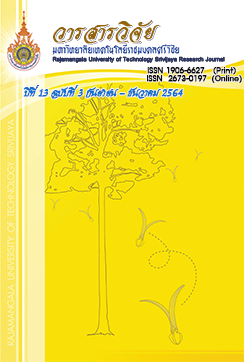ประสิทธิภาพของสารสกัดหยาบจากฝอยทองและแบคทีเรีย ต่อการควบคุมไรไข่ปลา
คำสำคัญ:
สารสกัดฝอยทอง, ไรไข่ปลา, แบคทีเรีย, เห็ดหูหนูบทคัดย่อ
ไรไข่ปลา (Luciaphorus perniciosus Rack, 1983) เป็นศัตรูสำคัญของการผลิตเห็ดในประเทศไทยทำให้การผลิตเห็ดลดลงได้ การวิจัยครั้งนี้จึงมีวัตถุประสงค์เพื่อหาประสิทธิภาพของสารสกัดหยาบจากฝอยทองชนิด Cuscuta reflexa Roxb. และ C. chinensis Lam. และแบคทีเรียเพื่อการควบคุมไรไข่ปลาในเห็ดหูหนู เตรียมสารสกัดหยาบจากฝอยทองที่ระดับความเข้มข้นที่ 0, 0.5, 1.0, 2.5 และ 5.0% w/v และการเตรียมสารละลายของแบคทีเรียที่แยกได้จากเห็ด ความเข้มข้น 1×108 CFU/mL ในการทดสอบสารด้วยการสัมผัส ใช้ไรไข่ปลาในระยะท้องจำนวน 3 ซ้ำๆ ละ 10 ตัว/ความเข้มข้น/สารสกัด โดยใช้เมล็ดข้าวฟ่างที่มีเส้นใยเห็ดเป็นอาหาร และทดสอบอัตราการตายที่ระยะ 3, 5, 7 และ 9 วัน พบว่า สารสกัดหยาบจากต้นฝอยทองชนิด C. reflexa มีค่า LC50 ต่อไข่ของไร ที่ 3, 5, 7 และ 9 วัน เท่ากับ 22.86, 12.25, 5.87 และ 2.01% w/v ตามลำดับ ขณะที่สารสกัดหยาบจากต้นฝอยทองชนิด C. chinensis มีค่า LC50 ต่อไข่ของไร เท่ากับ 16.59, 7.34, 2.18 และ 1.78% w/v ตามลำดับ ทั้งนี้ความเข้มข้นที่ 5% w/v ฝอยทองชนิด C. chinensis มีผลทำให้ไรตายร้อยละ 100 ภายหลังการทดสอบที่ 7 วัน สำหรับฝอยทองชนิด C. chinensis และ ที่ 9 วัน สำหรับฝอยทองชนิด C. reflexa ในทางตรงกันข้ามสารละลายของแบคทีเรียในการทดสอบครั้งนี้ไม่สามารถยับยั้งไรไข่ปลาระยะท้องได้ แม้กระนั้นก็ตามผลการวิจัยนี้ มีข้อแนะนำว่าสารสกัดจากฝอยทองทั้งสองสายพันธุ์
มีแนวโน้มที่ดีในการนำไปประยุกต์ใช้เพื่อป้องกัน และกำจัดไรไข่ปลา และไรชนิดอื่นๆ ที่เข้าทำลายฟาร์มเห็ด
เอกสารอ้างอิง
Alali, S., Mereghetti, V., Faoro, F., Bocchi, S., Al Azmeh, F. and Montagna, M. 2019. Thermotolerant isolates of Beauveria bassiana as potential control agent of insect pest in subtropical climates. PLoS ONE 14(2): 1-13. e0211457.
Babar, M.H., Afzal, M., Bashir, M.H. and Asif, M. 2005. Chemical control of mushroom mite (Tarsonimidae) at different time intervals and concentrations of dicofol, abamectin and hexythiazox. Pakistan Journal of Agricultural Sciences 42(3-4): 42-44.
Bais, N. and Kakkar, A. 2013. Comparative phytochemical analysis of Cuscuta reflexa parasite grown on Cassia fistula and Ficus benghlensis by GC-MS. International Journal of Pharmacy and Pharmaceutical Sciences 5(4): 350-355.
Bugti, G.A., Bin, W., Lin, H.F., Na, C. and Feng L.H. 2018. Pathogenicity of Beauveria bassiana strain 202 against sap-sucking insect pests. Plant Protection Science 54(1): 111-117.
Bussaman, P., Sa-uth, C., Chandrapatya, A., Atlihan, R., Gökçe, A., Saska, P. and Chi, H. 2017. Fast population growth in physogastry reproduction of Luciaphorus perniciosus (Acari: Pygmephoridae) at different temperatures. Journal of Economic Entomology 110(4): 1397-1403. https://doi.org/10.1093/jee/tox102.
Bussaman, P., Sa-uth, C., Rattanasena, P. and Chandrapatya, A. 2012. Effect of crude Plant plant extracts on mushroom mite, Luciaphorus sp. (Acari: pygmephoridae). Psyche A Journal of Entomology 2012 (ID 150958): 1-5. doi: https://doi.org/10.1155/2012/150958.
Chaowattanawong, P., Prasoetphon, A. and Kongchuensin, M. 2011. Plant extract for controlling Luciaphorus perniciosus Rack in Jew’s Ear Mushroom, pp. 413-147. Annual report 2011. Published documents, Plant protection research and development office, Department of Agriculture. (in Thai)
Dambolena, J.S., Zunino, M.P., Herrera, J.M., Pizzolitto, R.P., Areco, V.A. and Zygadlo, J.A. 2016. Terpenes: natural products for controlling insects of importance to human health-A structure-activity relationship study. Psyche: A Journal of Entomology 2016(ID 4595823): 1-17. https://doi.org/10.1155/2016/4595823.
IBM Corp. 2017. IBM SPSS Statistics for Windows, Version 25.0. Armonk, IBM Corp, NY.
Kulpiyawat, T. 2003. Mite pests of mushroom, Handout entitled “Insect-animal pests and their control”. 12th training, 24-28. March 2003, at His Majesty the Kings 6" Cycle Birthday Anniversary Building. Published documents, Division of Entomology and Zoology, Plant Protection Research and Development Office, Department of Agriculture, Bangkok. (in Thai)
Koohakan, P., Pumnuan, J., Insung, A., Lorcharoen, N. and Boonplain, A. 2014. Effect of essential oils from black pepper (Piper nigrum Linn.), lemon grass (Cymbopogon citratus (Dc. ex Nees)) and citronella grass (Cymbopogon nardus Rendle.) against the growth of some mushroom cultures. Khon Kaen Agriculture Journal 42(1): 7-16. (in Thai)
Mateen, A., Suresh, P.V.K. and Ahmed, P. 2011. Evaluation of antibacterial activity of Cuscuta reflexa and abutilon Abutilon indicum. International Journal of Pharma and Bio Sciences 2(4): 355-361.
Patel, S., Sharma, V., Chauhan, N.S. and Dixit, V.K. 2012. An updated review on the parasitic herb of Cuscuta reflexa Roxb. Journal of Chinese Integrative Medicine 10(3): 249-255.
Perveen, S., Bukhari, I.H., Ain, Q.U., Kousar. S. and Rehman, J. 2013. Antimicrobial, antioxidant and minerals evaluation of Cuscuta europea and Cuscuta reflexa collected from difference hosts and exploring their role as functional attribute. International Research Journal of Pharmaceutical and Applied Sciences 3(5): 43-49.
Pumnuan, J., Chandrapatya, A. and Insung, A. 2010. Acaricidal activities of plant essential oils from three plants on the mushroom mite, Luciaphorus perniciosus Rack (Acari: Pygmephoridae). Pakistan Journal of Zoology 42(3): 247-252.
Pumnuan, J., Insung, A. and Rongpol, P. 2009. Effectiveness of medical plant essential oils on pregnant female of Luciaphorus perniciosus Rack (Acari: Pygmephoridae). Asian Journal of Food and Agro-Industry 2(Special Issue): S410-S414.
Saringkaphaibu, C., Chiengkul, A. and Jaronnasri, W. 2000. Mushroom mite, p. 23-42. Handout entitled “Insect-animal pests and their control”, 12th training, Division of Entomology and Zoology. Published documents, Plant Protection Research and Development Office, Department of Agriculture, Bangkok. (in Thai)
Sieniawska, E., Swatko-Ossor, M., Sawicki, R., Skalicka-Woźniak, K. and Ginalska, G. 2017. Natural terpenes influence the activity of antibiotics against isolated Mycobacterium tuberculosis. Medical Principles and Practice 26(2): 108-112. https://doi.org/10.1159/000454680.
Sobanbou, S., Bussaman, P and Chandrapatya, A. 2009. The efficacy of Xenorhabdus spp. against mushroom mite (Luciaphorus spp.). Journal of Science and Technology Mahasarakham University 28(1): 1-7. (in Thai)
Tanruean, K., Kaewnarin, K., Suwannarach, N. and Lumyong, S. 2017. Comparative evaluation of phytochemicals, and antidiabetic and antioxidant activities of Cuscuta reflexa grown on different hosts in northern Thailand. Natural Product Communications 12(1): 51-54.
Tanruean, K., Poolprasert, P., Kumla, J., Suwannarach, N. and Lumyong, S. 2019a. Bioactive compounds content and their biological properties of acetone extract of Cuscuta reflexa Roxb. grown on various host plants. Natural Product Research 33(4): 544-547.
Tanruean, K., Napiroon, T., Phusing, S., Torres, J. R.D., Villanueva, P.M. and Poolprasert, P. 2019b. Larvicidal effects of Paederia pilifera Hook.f. leaf and Cuscuta reflexa Roxb. stem extracts against the dengue vector mosquito Aedes aegypti Linn. The Journal of Applied Science 18(1): 31-38.
Vijikumar, S., Ramanathan, K. and Devi, B.P. 2011. Cuscuta reflexa Roxb. A wonderful miracle plant in ethnomedicine. Indian Journal of Natural Sciences 11(9): 676-683.
Yenjit, P. and Intana, W. 2016. Study on efficacy of Bacillus powder and its application to control black mold disease of grey oyster mushroom. Agricultural Science Journal 47(3): 405-406. (in Thai)
ดาวน์โหลด
เผยแพร่แล้ว
รูปแบบการอ้างอิง
ฉบับ
ประเภทบทความ
สัญญาอนุญาต
เนื้อหาและข้อมูลในบทความที่ลงตีพิมพ์ในวารสารวิจัยมหาวิทยาลัยเทคโนโลยีราชมงคลศรีวิชัย ถือเป็นข้อคิดเห็นและความรับผิดชอบของผู้เขียนบทความโดยตรง ซึ่งกองบรรณาธิการวารสารไม่จำเป็น ต้องเห็นด้วย หรือร่วมรับผิดชอบใดๆ
บทความ ข้อมูล เนื้อหา รูปภาพฯลฯ ที่ได้รับการตีพิมพ์ในวารสารวิจัย มหาวิทยาลัยเทคโนโลยีราชมงคลศรีวิชัย ถือเป็นลิขสิทธ์ของวารสารวิจัย มหาวิทยาลัยเทคโนโลยีราชมงคลศรีวิชัย หากบุคคลหรือหน่วยงานใดต้องการนำทั้งหมดหรือส่วนหนึ่งส่วนใดไปเผยแพร่ต่อหรือเพื่อการกระทำการใดๆจะต้องได้รับอนุญาตเป็นลายลักษ์อักษรจากวารสาร มหาวิทยาลัยเทคโนโลยีราชมงคลศรีวิชัยก่อนเท่านั้น







